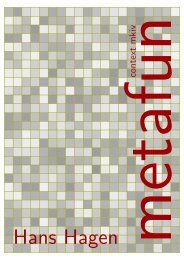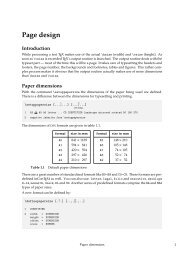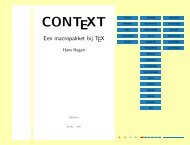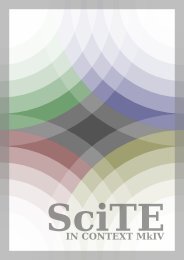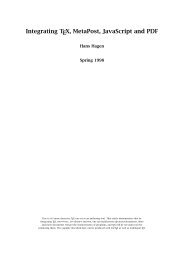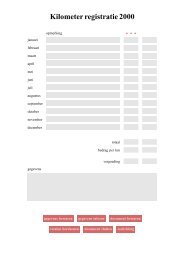Hagen - Pragma ADE
Hagen - Pragma ADE
Hagen - Pragma ADE
Create successful ePaper yourself
Turn your PDF publications into a flip-book with our unique Google optimized e-Paper software.
The second variant is seldom used and is only provided because some users have fonts<br />
defined in the X Ǝ T E X way. Users are advised not to use this method. The last method<br />
is special in the sense that it’s used to define fonts that are constructed using the built<br />
in virtual font constructors. This method is for instance used for defining virtual math<br />
fonts.<br />
The first method is what we use most. It is really important not to forget the feature<br />
specification. A rather safe bet is *default. In a next chapter we will discuss the<br />
difference between these two; here we focus on the name part.<br />
The filename is in fact a symbolic name. In ConT E Xt we have always used an indirect<br />
reference to fonts. Look at this:<br />
\definefont[TitleFont][SerifBold*default sa 2]<br />
A reference like SerifBold makes it possible to define styles independent of the chosen<br />
font family. This reference eventually gets resolved to a real name and there can be a<br />
chain of references.<br />
Font definitions can be grouped into a larger setup using typescripts. In that case,<br />
we can set the features for a regular, italic, bold and bolditalic for the whole set but<br />
when a fontname has a specific feature associated (as in the previous examples) that<br />
one takes precedence.<br />
so far we talked about fonts being files, but in practice a lookup happens by file as<br />
well as by name as known to the system. In the next section this will be explained in<br />
more detail.<br />
3.3 File<br />
You can force a file lookup with:<br />
\definefont[TitleFont][file:somefilename*default sa 2]<br />
If you use more symbolic names you can use the file: prefix in the mapping:<br />
\definefontsynonym[SerifBold][file:somefile]<br />
\definefont[TitleFont][SerifBold*default sa 2]<br />
In projects that are supposed to run for a long time I always use the file based lookup,<br />
because filenames tend to be rather stable. Also, as the lookup happens in the T E X<br />
directory structure, file lookups will rely on the general file search routines. This has<br />
the benefit that case is ignored. When no match is found the lookup will also use the<br />
font name database. Spaces and special characters are ignored.<br />
The name alone is not enough as there can be similar filenames with different suffixes.<br />
Therefore the lookup will happen in the order otf, ttf, afm, tfm and lua. You can force<br />
a lookup by being more explicit, like:<br />
\definefont[TitleFont][file:somefilename.ttf*default sa 1]<br />
47<br />
Lookups



